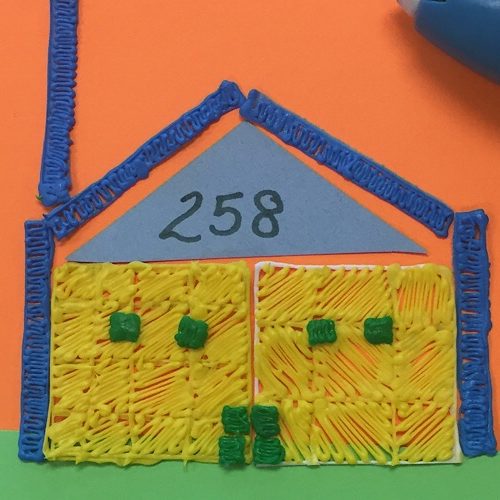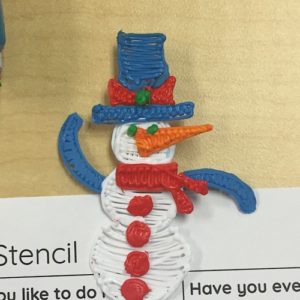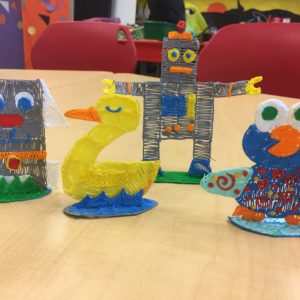MATH: Doodle Place Value Art
In this activity, students will work in pairs to doodle ones, tens, and hundreds "base ten blocks" using a pre-made stencil. Each partner will then arrange the blocks to create his or her own picture and then determine the value of the picture by adding up the ones, tens and hundreds used.

Knowledge
Students have
practiced with the 3Doodler.
had practice drawing straight lines, outlines and fill with the 3Doodler.
practiced place value using "base ten blocks," i.e., ones, tens and hundreds.
practiced with the 3Doodler.
had practice drawing straight lines, outlines and fill with the 3Doodler.
practiced place value using "base ten blocks," i.e., ones, tens and hundreds.
Objectives
Students will
doodle "base ten blocks," i.e., ones, tens and hundreds.
will determine which blocks to use to create a picture.
arrange their selected base ten blocks to create a picture.
determine the value of the picture by counting up the total of base ten blocks used.
doodle "base ten blocks," i.e., ones, tens and hundreds.
will determine which blocks to use to create a picture.
arrange their selected base ten blocks to create a picture.
determine the value of the picture by counting up the total of base ten blocks used.
Materials
Students will need
3Doodler (1 per pair)
Doodle-Base Ten Blocks Worksheet (1 per pair)
Colored construction paper (2-3 sheets per pair)
3Doodler (1 per pair)
Doodle-Base Ten Blocks Worksheet (1 per pair)
Colored construction paper (2-3 sheets per pair)
Lesson Plan
Instructions
Step 2
Whole Group: Review counting with base ten blocks using ones, tens and hundreds blocks.
Step 3
Ask students: How many ones are in a ten? How many tens are in a hundred? Count ones and tens along with students.
Step 4
Project your tablet or computer screen on the board to display the Doodle-Base Ten Blocks Worksheet.
Step 5
Share the goal: During this session, students will use the 3Doodler to doodle ones, tens and hundreds using three different colors, e.g., hundreds-yellow, tens-blue, ones-red.
Step 6
Model how to use the 3Doodler to doodle the ones, tens and hundreds. Outline first and then fill by using a back and forth motion. Note that it’s critical to touch the outline as you move back and forth in order to create a solid piece. When filling in the hundreds block, segment it into smaller sections, which are easier to fill with the 3Doodler.
Step 7
Note: All hundreds blocks should be the same color. All tens blocks should be the same color. All ones blocks should be the same color.
Step 8
Peel base ten blocks off stencils and arrange to create a picture. Demonstrate how to move blocks around on the paper until you get an idea. Note that you do not need to use all of the blocks.
Step 9
Integrate grammar concepts by noting that students will be arranging the base ten blocks to create a noun, i.e, a person, place or thing.
Step 10
After creating a picture with a selected number of base ten blocks, ask students to help you count up the total value of your picture, e.g., 258.
Step 11
Explain that partners will take turns creating pictures using the same blocks. Take a digital picture of each student's art before their partner rearranges their work.
Step 12
Pair off students and hand out 3Doodlers and the Doodle-Base Ten Blocks
Worksheet. Circle to assist and assess. Take digital pictures of students’ art.
Whole Group: Review counting with base ten blocks using ones, tens and hundreds blocks.
Ask students: How many ones are in a ten? How many tens are in a hundred? Count ones and tens along with students.
Project your tablet or computer screen on the board to display the Doodle-Base Ten Blocks Worksheet.
Share the goal: During this session, students will use the 3Doodler to doodle ones, tens and hundreds using three different colors, e.g., hundreds-yellow, tens-blue, ones-red.
Model how to use the 3Doodler to doodle the ones, tens and hundreds. Outline first and then fill by using a back and forth motion. Note that it’s critical to touch the outline as you move back and forth in order to create a solid piece. When filling in the hundreds block, segment it into smaller sections, which are easier to fill with the 3Doodler.
Note: All hundreds blocks should be the same color. All tens blocks should be the same color. All ones blocks should be the same color.
Peel base ten blocks off stencils and arrange to create a picture. Demonstrate how to move blocks around on the paper until you get an idea. Note that you do not need to use all of the blocks.
Integrate grammar concepts by noting that students will be arranging the base ten blocks to create a noun, i.e, a person, place or thing.
After creating a picture with a selected number of base ten blocks, ask students to help you count up the total value of your picture, e.g., 258.
Explain that partners will take turns creating pictures using the same blocks. Take a digital picture of each student's art before their partner rearranges their work.
Pair off students and hand out 3Doodlers and the Doodle-Base Ten Blocks
Worksheet. Circle to assist and assess. Take digital pictures of students’ art.
Wrap Up
Assessment
Possible Extensions
Resources
Vocabulary
art - the quality, production, expression, or realm, according to aesthetic principles, of what is beautiful, appealing, or of more than ordinary significance.
base ten - the Base-10 number system is known as the decimal system and has 10 digits to show all numbers 0,1,2,3,4,5,6,7,8,9 using place value and a decimal point to separate whole numbers from decimal fractions.
block - a quantity, number, or section of things dealt with as a unit.
collaboration - to work jointly with others or together especially in an intellectual endeavor.
counting - to indicate or name by units or groups so as to find the total number of units involved.
creativity - the quality of having or showing an ability to make new things or think of new ideas.
hundreds - a reference to a quantity or quantities of a unit of 100.
ones - a reference to a quantity or quantities of a unit of 1.
place value - The value of where the digit is in the number. (Example: In 352, the 5 is in the "tens" place, so it really means 50.)
problem-solving - the process or act of finding a solution to a problem.
tens - a reference to a quantity or quantities of a unit of 10.
Educational Standards
Understand that the three digits of a three-digit number represent amounts of hundreds, tens, and ones; e.g., 706 equals 7 hundreds, 0 tens, and 6 ones.
Students will arrange and calculate the value of their art based on the number of ones, tens and hundreds blocks used.
100 can be thought of as a bundle of ten tens — called a "hundred."
Students will count the number of tens in a hundred block.
The numbers 100, 200, 300, 400, 500, 600, 700, 800, 900 refer to one, two, three, four, five, six, seven, eight, or nine hundreds (and 0 tens and 0 ones).
Students will count the number of hundred blocks used in their art and include it in their calculation of the picture's total value.
Decompose (break down) a larger problem into smaller sub-problems with teacher guidance or independently.
Students will break down the process of calculating place value into 3D modeling, creative art, and calculation.
Use technology to seek feedback that informs and improves their practice and to demonstrate their learning in a variety of ways.
Students will use the 3Doodler to create doodled models of place value to be used in an artistic math activity.
Create original works or responsibly repurpose or remix digital resources into new creations.
Students will use a 3Doodler to create place value blocks and creatively reinterpret them as art.
Use collaborative technologies to work with others, including peers, experts or community members, to examine issues and problems from multiple viewpoints.
Students will seek feedback from peers and teacher throughout the process.


